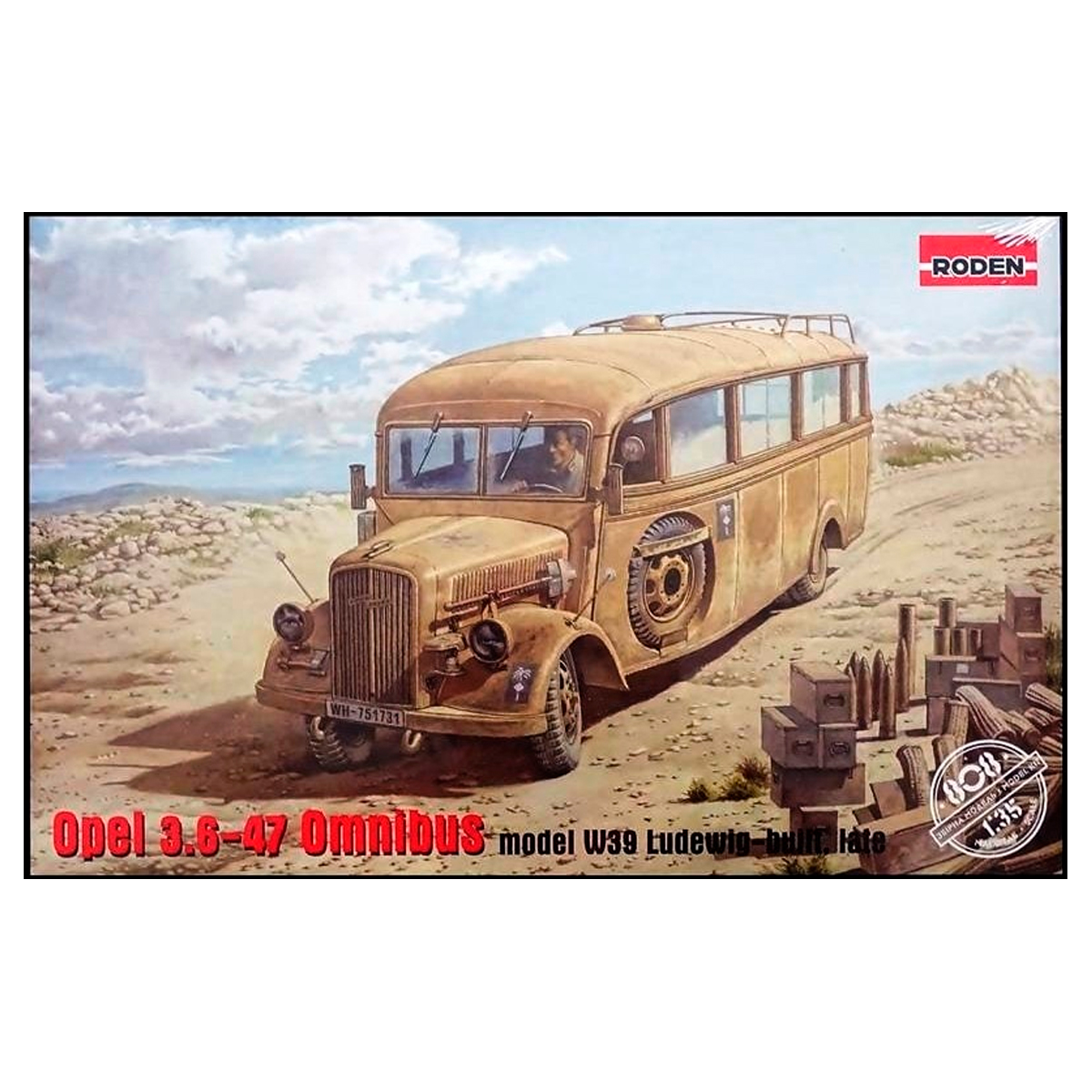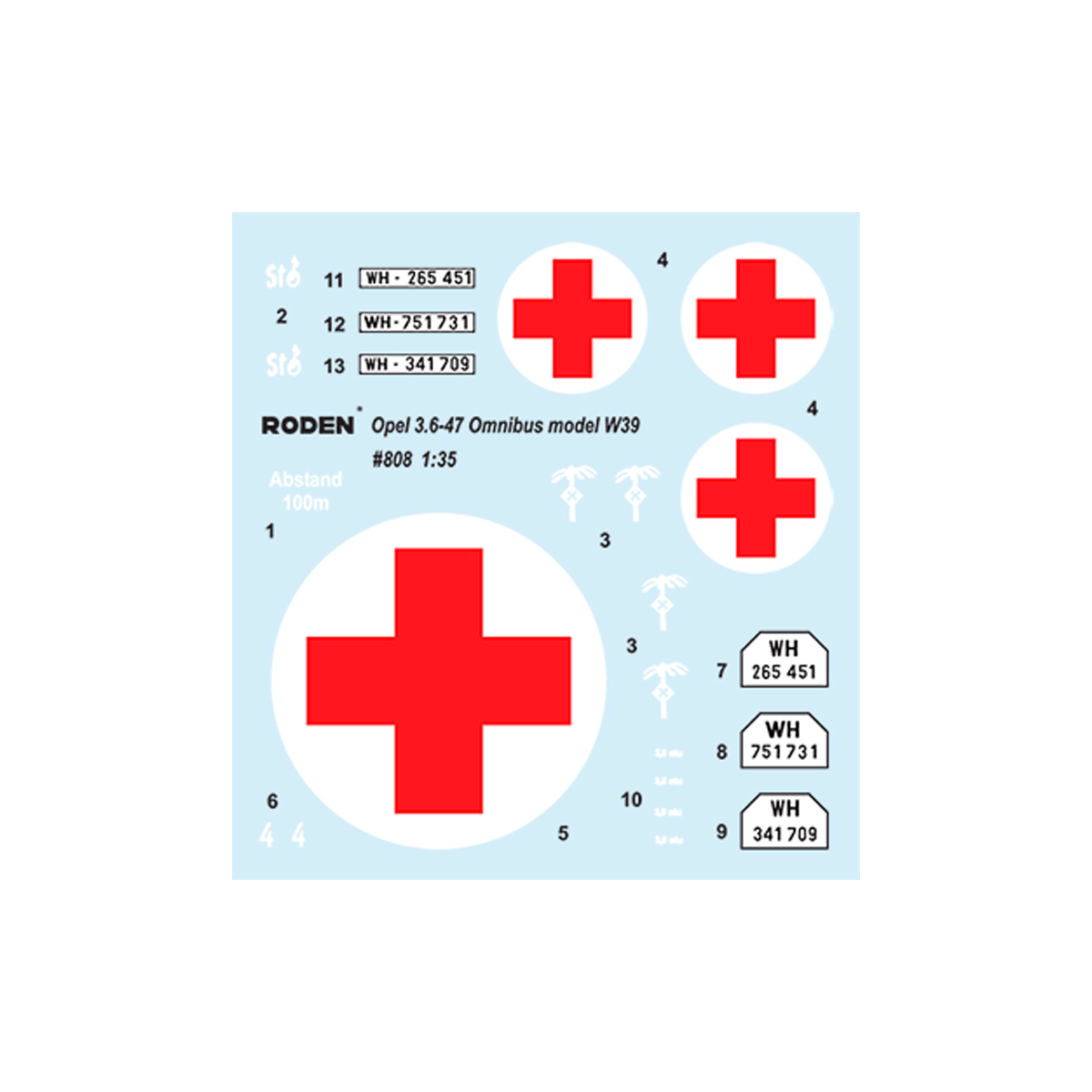1/35 Opel 3.6–47 Omnibus model W39 Ludewig built, late
45,99€
Solo quedan 1 disponibles

*Please check our Privacy Policies to see how to we use your personal data.
*Por favor revisa nuestra Política de Privacidad para ver como tratamos tus datos personales
Roden 1/35 Opel 3.6–47 Omnibus model W39 Ludewig built, late
In 1939 Germany was rapidly preparing for global hostilities. The plans of the German command supposed an instantaneous capture of quite large areas of other countries, and therefore special attention was paid to the question of the greatest possible motorization of infantry units. Besides a large number of different types of trucks which were already in the Wehrmacht’s inventory, staff buses also began to be taken on charge, whose main task was the conveyance of officers during offensive actions of the army with a likely prospect of minimal resistance by an opposing party in the conflict.
The practice of building buses on a truck’s chassis had existed for a long time, and therefore the most common types of buses which came into the German’s inventory were based on the most widely used trucks. One of the most popular trucks at this time was the well-known Opel Blitz, and on its chassis was designed a standard army bus (at the time the more common term for it was «omnibus»).
The Ludewig firm which was engaged in designing the bus, was located in Essen and had great experience in the manufacture of civilian multiseat vehicles. The standard chassis of the three ton truck was extended a little bit (up to 4450 mm), and the frame structure was reinforced. The original all-metal body of the new bus was quite elegant in outline, and only the front part where the engine was hidden, and the classic radiator with its distinctive logo, immediately reminded one of its predecessor, the famous «Blitz». Inside the cabin were several rows of seats which could be easily demounted if necessary (transportation of bulk goods, medical equipment, etc.).
Series production of the bus, officially designated the Opel 3.6-47 type W39, started in the second half of 1939, almost at the same time as the invasion of Poland by Germany and the start of WWII. At first, the number of vehicles produced per month was very small, but already in 1940 about one hundred units per month off were coming off the production line in Essen. During the manufacturing process of the bus a number of changes were made to its construction which were reflected in its appearance. For one, the spare wheel was moved from under the rear frame on its left hand side to a special niche in a side panel. Single molding under the windows was replaced by a double form. Series production lasted until mid-1943, when the situation became worse for Germany at the Front, basic industrial materials were in short supply, and as a result, Ludewig had to seriously simplify the structure of the bus. During this period 2,880 units of the early version were produced overall, which were sent both to the Eastern Front in Russia, and to the Afrika Corps of General Rommel in North Africa.
In addition to its main purpose – the conveyance of Wehrmacht officers – buses had to perform various other functions such as those of mobile headquarters, telephone exchange and radio station, mobile bakery and laundry, etc. Special note should be made of their role in transporting
wounded from battlefield to hospital – rows of seats were removed and in their place several stretchers with wounded could be easily brought through the back door that opened into the interior, thus leaving space free for the installation of medical equipment.
Opel Blitz 3.6-47 buses were used by the army until the very end of the war, but immediately afterwards they quickly disappeared, giving way to more modern developments of the Opel concern during the early postwar years.
Marking:
- Opel 3.6-47 Blitz Omnibus, WH-341709, unknown unit, France, middle 1941.
- Opel 3.6-47 Blitz Omnibus, WH-265451, Estern Front, unknown medical unit, early 1942.
- Opel 3.6-47 Blitz Omnibus, WH-751731, Afrika Korps, Tunisia, early 1943.
Roden 1/35 Opel 3.6–47 Omnibus model W39 Ludewig built, late
En 1939 Alemania se preparaba rápidamente para las hostilidades mundiales. Los planes del mando alemán suponían la captura instantánea de zonas bastante extensas de otros países, por lo que se prestó especial atención a la cuestión de la mayor motorización posible de las unidades de infantería. Además de un gran número de diferentes tipos de camiones que ya se encontraban en el inventario de la Wehrmacht, también comenzaron a cargarse autobuses de Estado Mayor, cuya tarea principal era el transporte de oficiales durante las acciones ofensivas del ejército con una perspectiva probable de mínima resistencia por parte de un adversario en el conflicto.
La práctica de construir autobuses sobre el chasis de un camión existía desde hacía mucho tiempo, por lo que los tipos más comunes de autobuses que entraban en el inventario de los alemanes se basaban en los camiones más utilizados. Uno de los camiones más populares en aquella época era el conocido Opel Blitz, y sobre su chasis se diseñó un autobús militar estándar (en aquella época el término más común para él era «ómnibus»).
La empresa Ludewig, que se encargó de diseñar el autobús, estaba situada en Essen y tenía gran experiencia en la fabricación de vehículos civiles multistación. El chasis estándar del camión de tres toneladas se amplió un poco (hasta 4450 mm) y se reforzó la estructura del bastidor. La carrocería original totalmente metálica del nuevo autobús era de líneas bastante elegantes, y sólo la parte delantera, donde se ocultaba el motor, y el clásico radiador con su logotipo distintivo, recordaban inmediatamente a su predecesor, el famoso «Blitz». En el interior de la cabina había varias filas de asientos que podían desmontarse fácilmente en caso necesario (transporte de mercancías a granel, equipos médicos, etc.).
La producción en serie del autobús, denominado oficialmente Opel 3.6-47 tipo W39, comenzó en la segunda mitad de 1939, casi al mismo tiempo que la invasión de Polonia por Alemania y el inicio de la Segunda Guerra Mundial. Al principio, el número de vehículos producidos al mes era muy reducido, pero ya en 1940 salían de la línea de producción de Essen unas cien unidades mensuales. Durante el proceso de fabricación del autobús se introdujeron una serie de cambios en su construcción que se reflejaron en su aspecto. Por ejemplo, la rueda de repuesto se trasladó de debajo del bastidor trasero del lado izquierdo a un hueco especial en un panel lateral. La moldura simple bajo las ventanillas se sustituyó por una doble. La producción en serie duró hasta mediados de 1943, cuando la situación empeoró para Alemania en el Frente, escaseaban los materiales industriales básicos y, en consecuencia, Ludewig tuvo que simplificar seriamente la estructura del autobús. Durante este período se produjeron en total 2.880 unidades de la primera versión, que fueron enviadas tanto al Frente Oriental en Rusia, como al Cuerpo Afrika del general Rommel en el norte de África.
Además de su función principal, el transporte de oficiales de la Wehrmacht, los autobuses debían desempeñar otras funciones, como las de cuartel general móvil, central telefónica y emisora de radio, panadería y lavandería móviles, etc. Cabe destacar su papel en el transporte de heridos del campo de batalla al hospital: se eliminaban las filas de asientos y en su lugar se podían introducir fácilmente varias camillas con heridos a través de la puerta trasera que se abría al interior, dejando así espacio libre para la instalación de equipos médicos.
Los autobuses Opel Blitz 3.6-47 fueron utilizados por el ejército hasta el final de la guerra, pero inmediatamente después desaparecieron, dando paso a desarrollos más modernos de la marca Opel durante los primeros años de la posguerra.
Marcas:
- Opel 3.6-47 Blitz Omnibus, WH-341709, unidad desconocida, Francia, mediados de 1941.
- Opel 3.6-47 Blitz Omnibus, WH-265451, Frente Oriental, unidad médica desconocida, principios de 1942.
- Opel 3.6-47 Blitz Omnibus, WH-751731, Afrika Korps, Túnez, principios de 1943.






 Solicitud de ficha producto tipo SDS / Seguridad de producto
Solicitud de ficha producto tipo SDS / Seguridad de producto